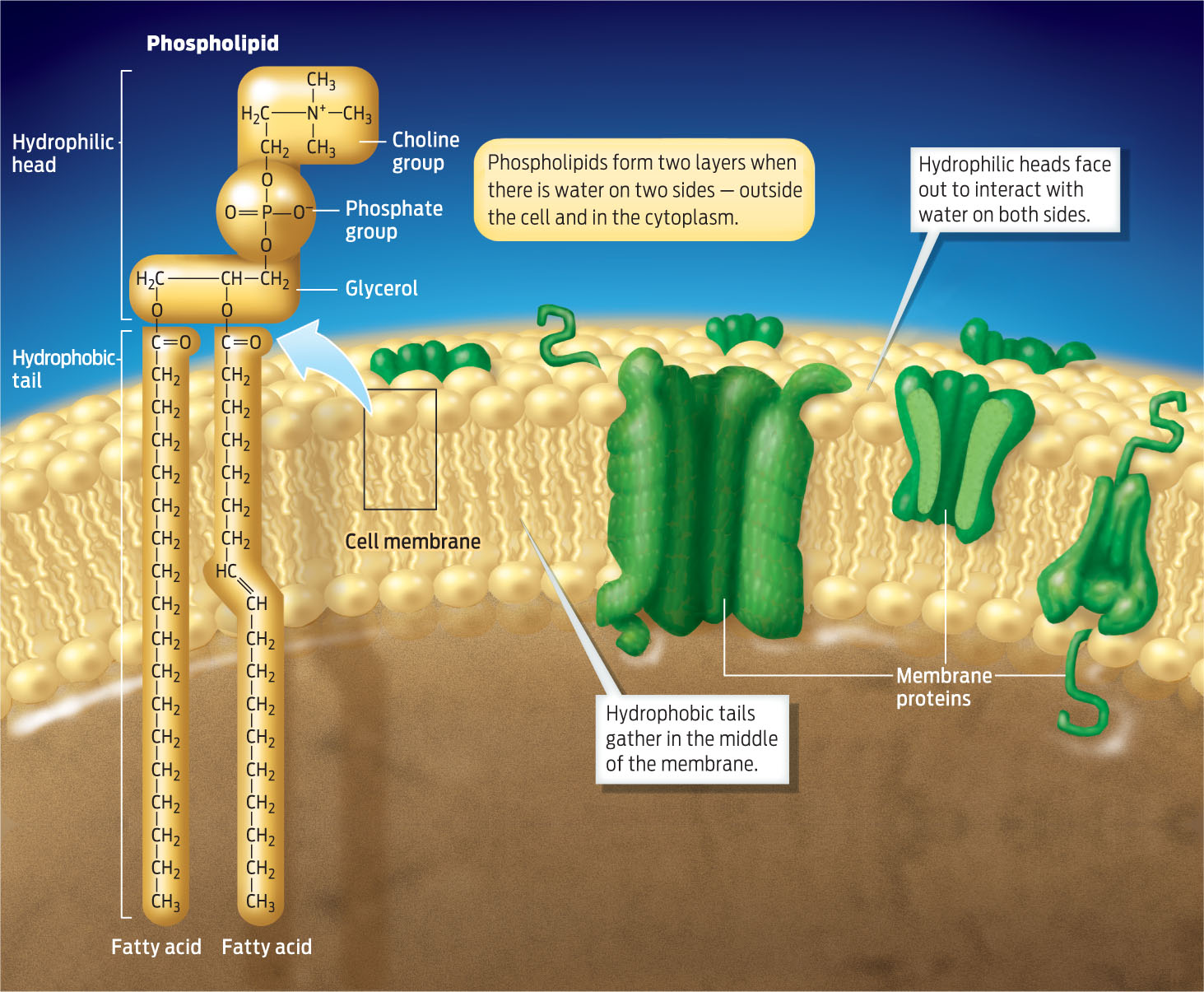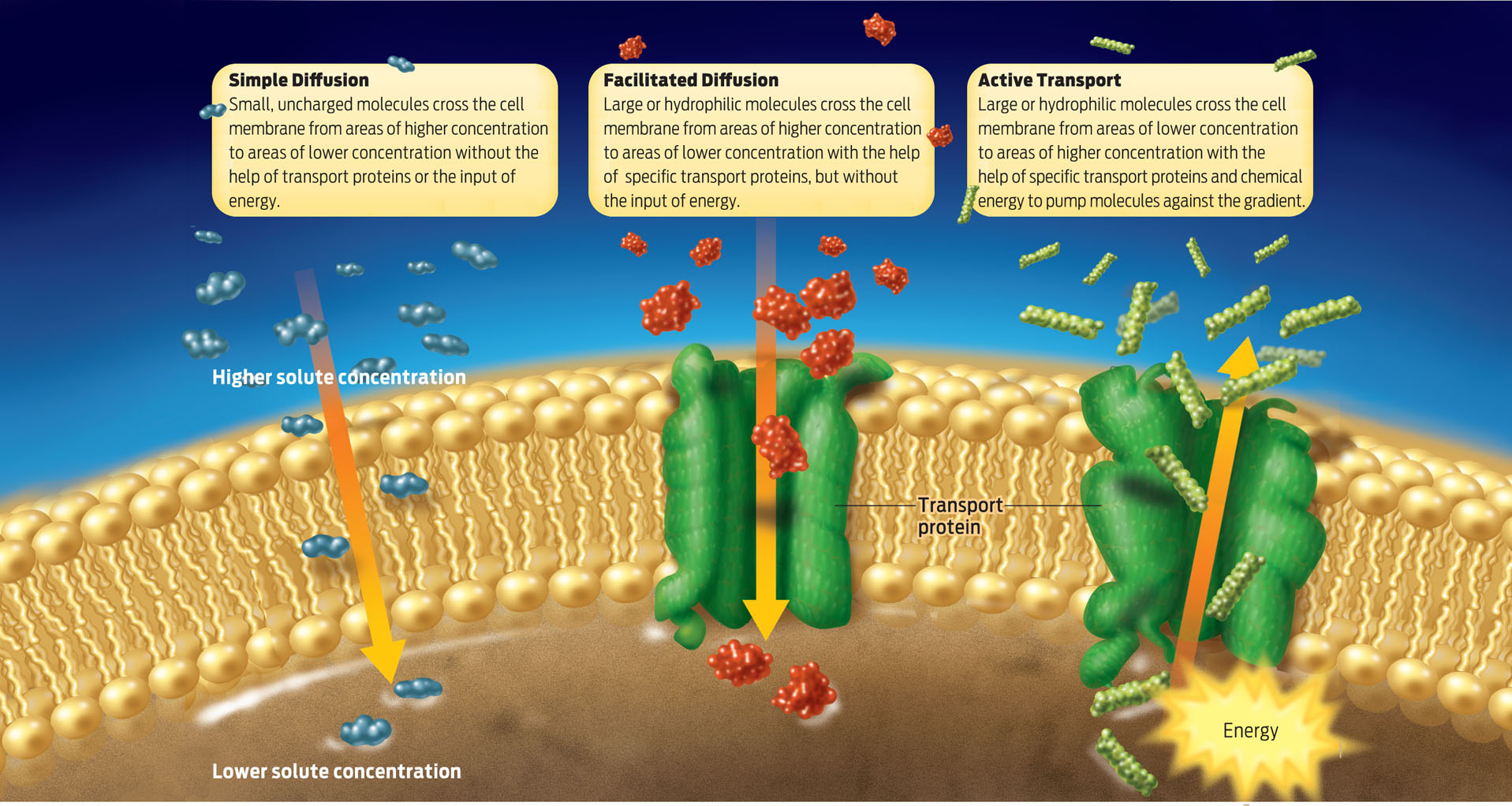CROSSING ENEMY LINES
For any drug to be effective, it has to reach its designated target. In the case of many antibiotics, that means getting inside the cell to do their work. But the cell membrane, which surrounds all cells, acts as a barrier to the free flow of substances into the cell. How do antibiotics get past this barrier?
Consider the structure of the cell membrane. Phospholipids comprise the bulk of the membrane. They have two main parts: a hydrophilic “head” and a hydrophobic “tail.” In the watery context of a cell, the hydrophobic tails cluster together in the middle of the membrane away from water, while the hydrophilic heads face outward, toward water. When arranged in this way, the phospholipids form a two-ply structure called a bilayer. Proteins sit nestled in the lipid bilayer, where they perform a variety of functions such as transporting nutrients in and wastes out. The membrane is semipermeable: only certain substances can cross it freely (INFOGRAPHIC 3.6).
Membranes are semipermeable, selectively allowing the passage of substances from one side to the other.

SIMPLE DIFFUSION The movement of small, hydrophobic molecules across a membrane from an area of higher concentration to an area of lower concentration; simple diffusion does not require an input of energy.
With its densely packed collection of hydrophobic phospholipid tails, the lipid bilayer is largely impermeable to large molecules, like glucose, and hydrophilic (or charged) substances, like sodium ions, and only weakly permeable to water. In fact, the only things that do cross the lipid bilayer easily are small, uncharged molecules like oxygen (O2), which cross by simple diffusion. Diffusion is the natural tendency of dissolved substances to move from an area of higher concentration to one of lower concentration-think of food coloring dispersing in a glass of water. In simple diffusion, the substance moves directly through the phospholipids of the membrane, from the side of the membrane with a higher concentration to the side with a lower concentration, thus balancing the concentrations on both sides. Because substances naturally move from an area of higher concentration to an area of lower concentration, no additional energy is required for this movement beyond what is stored in the concentration difference, or gradient, itself.
“Penicillin seemed to justify a carefree attitude to infection. In Western countries, for the first time in human history, most people felt that infectious disease was ceasing to be a threat.”
— ROBERT BUD
Take oxygen, for example. The concentration of oxygen molecules, which are small and uncharged, is often higher outside the cell and lower inside it. This concentration gradient allows oxygen to diffuse easily into the cell-a good thing, because the cell needs oxygen in order to survive. In particular, oxygen is needed to convert chemical energy from the diet into usable energy to carry out cellular work (see Chapter 6).
TRANSPORT PROTEINS Proteins involved in the movement of molecules across the cell membrane.
But the cell also needs some large or hydrophilic molecules in order to survive-one of them is glucose, the cell’s energy source. To move such molecules across the membrane the cell makes use of transport proteins. Transport proteins sit in the membrane bilayer with one of their ends outside the cell and the other inside it. By acting as a kind of channel, carrier, or pump, transport proteins provide a passageway for those large or hydrophilic molecules to cross the membrane. They are also very specific: a protein that transports glucose will not transport calcium ions, for example. The cells of the body contain hundreds of different transport proteins.
FACILITATED DIFFUSION The process by which large or hydrophilic solutes move across a membrane from an area of higher concentration to an area of lower concentration with the help of transport proteins; facilitated diffusion does not require an input of energy.
Transport proteins can move substances either with or against a concentration gradient–either “downhill” or “uphill” across the membrane. When a substance moves downhill by a transport protein from an area of higher concentration to an area of lower concentration, the process is called facilitated diffusion. Like simple diffusion, facilitated diffusion requires no additional energy besides that in the concentration gradient. For this reason, facilitated diffusion is also sometimes known as passive transport. Many substances enter the cell by facilitated diffusion–glucose and water, for example. (Osmosis, discussed above, relies on both simple diffusion through the lipid bi-layer and facilitated diffusion through transport proteins to passively move water through the membrane.)
Antibiotics move across membranes in a number of ways. Some antibiotics are small hydrophobic molecules that can cross the cell membrane directly by simple diffusion-tetra-cycline, for example. Others, including penicillin and streptomycin, pass through membranes by facilitated diffusion.
Just because an antibiotic makes it inside a bacterial cell, however, doesn’t mean it will stay there. Some bacteria have transport proteins that can actively pump the antibiotic back out of the cell. This bacterial counteroffensive measure is an example of active transport, in which proteins pump a substance uphill from an area of lower concentration to an area of higher concentration. Unlike facilitated diffusion, active transport requires an input of chemical energy. In this case, active transport keeps the antibiotic concentration in the bacterial cell low, but the cell must expend energy to keep pumping the antibiotic out against its concentration gradient (INFOGRAPHIC 3.7).
ACTIVE TRANSPORT The energy-requiring process by which solutes are pumped from an area of lower concentration to an area of higher concentration with the help of transport proteins.
Pumping antibiotics out of the bacterial cell is one way in which bacteria can resist the destructive power of an antibiotic. Others include chemically breaking down the antibiotic with enzymes. Why would bacteria have such built-in mechanisms for counteracting or resisting drugs? Remember that penicillin was originally isolated from a living organism, a fungus. Streptomycin comes from microorganisms living in soil. Microorganisms like these have evolved chemical defenses as a way to protect themselves from other organisms. In turn, their combatants have evolved counter-measures that give them resistance. Humans thus find themselves embroiled in a battle originally waged solely between microorganisms. We have “amplified a local warfare among microbes in a few grams of soil into a global planetary war between Man and Microbe,” wrote Alexander Tomasz, a microbiologist at the Rockefeller University, in the book Fighting Infection in the 21st Century. In the early 1980s, Tomasz helped discover how penicillin works, and is now an expert on antibiotic resistance.
